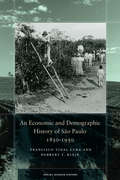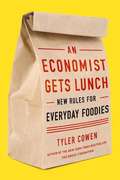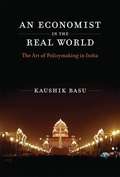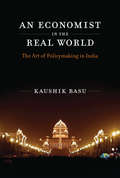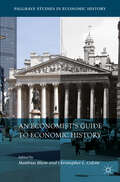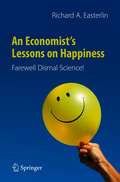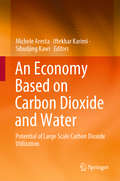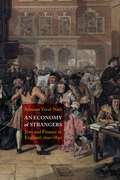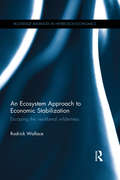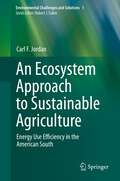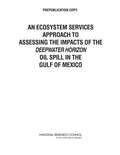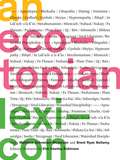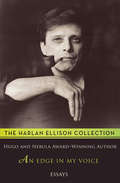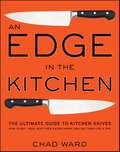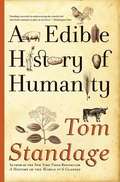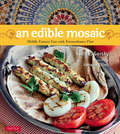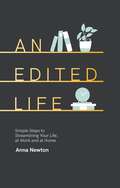- Table View
- List View
An Economic and Demographic History of São Paulo, 1850-1950 (Social Science History)
by Herbert S. Klein Francisco Vidal LunaSão Paulo, by far the most populated state in Brazil, has an economy to rival that of Colombia or Venezuela. Its capital city is the fourth largest metropolitan area in the world. How did São Paulo, once a frontier province of little importance, become one of the most vital agricultural and industrial regions of the world? <P><P>This volume explores the transformation of São Paulo through an economic lens. Francisco Vidal Luna and Herbert S. Klein provide a synthetic overview of the growth of São Paulo from 1850 to 1950, analyzing statistical data on demographics, agriculture, finance, trade, and infrastructure. <P>Quantitative analysis of primary sources, including almanacs, censuses, newspapers, state and ministerial-level government documents, and annual government reports offers granular insight into state building, federalism, the coffee economy, early industrialization, urbanization, and demographic shifts. <P>Luna and Klein compare São Paulo's transformation to other regions from the same period, making this an essential reference for understanding the impact of early periods of economic growth.
An Economic and Social History of the Ottoman Empire
by Halil Inalcik Donald QuataertDiscussion of the Ottoman Empire.
An Economist Gets Lunch: New Rules for Everyday Foodies
by Tyler CowenOne of the most influential economists of the decade-and the New York Times bestselling author of The Great Stagnation-boldly argues that just about everything you've heard about food is wrong. Food snobbery is killing entrepreneurship and innovation, says economist, preeminent social commentator, and maverick dining guide blogger Tyler Cowen. Americans are becoming angry that our agricultural practices have led to global warming-but while food snobs are right that local food tastes better, they're wrong that it is better for the environment, and they are wrong that cheap food is bad food. The food world needs to know that you don't have to spend more to eat healthy, green, exciting meals. At last, some good news from an economist! Tyler Cowen discusses everything from slow food to fast food, from agriculture to gourmet culture, from modernist cuisine to how to pick the best street vendor. He shows why airplane food is bad but airport food is good; why restaurants full of happy, attractive people serve mediocre meals; and why American food has improved as Americans drink more wine. And most important of all, he shows how to get good, cheap eats just about anywhere. Just as The Great Stagnation was Cowen's response to all the fashionable thinking about the economic crisis, An Economist Gets Lunch is his response to all the fashionable thinking about food. Provocative, incisive, and as enjoyable as a juicy, grass-fed burger, it will influence what you'll choose to eat today and how we're going to feed the world tomorrow. .
An Economist Goes to the Game: How to Throw Away $580 Million and Other Surprising Insights from the Economics of Sports
by Paul OyerAn engaging look at the ways economic thinking can help us understand how sports work both on and off the field Are ticket scalpers good for teams? Should parents push their kids to excel at sports? Why do Koreans dominate women’s golf, while Kenyans and Ethiopians dominate marathon racing? Why would Michael Jordan, the greatest player in basketball, pass to Steve Kerr for the game-winning shot? Paul Oyer shows the many ways economics permeates the world of sports. His topics range from the business of sport to how great athletes use economic thinking to outsmart their opponents to why the world's greatest sports powerhouse (at least per capita) is not America or China but the principality of Liechtenstein. Economics explains why some sports cannot stop the use of performance-enhancing drugs while others can, why hundred-million-dollar player contracts are guaranteed in baseball but not in football, how one man was able to set the world of sports betting on its ear—and why it will probably never happen again. This book is an entertaining guide to how a bit of economics can make you a better athlete and a more informed fan.
An Economist Walks into a Brothel: And Other Unexpected Places to Understand Risk
by Allison SchragerIs it worth swimming in shark-infested waters to surf a 50-foot, career-record wave?Is it riskier to make an action movie or a horror movie?Should sex workers forfeit 50 percent of their income for added security or take a chance and keep the extra money?Most people wouldn't expect an economist to have an answer to these questions--or to other questions of daily life, such as who to date or how early to leave for the airport. But those people haven't met Allison Schrager, an economist and award-winning journalist who has spent her career examining how people manage risk in their lives and careers. Whether we realize it or not, we all take risks large and small every day. Even the most cautious among us cannot opt out--the question is always which risks to take, not whether to take them at all. What most of us don't know is how to measure those risks and maximize the chances of getting what we want out of life.In An Economist Walks into a Brothel, Schrager equips readers with five principles for dealing with risk, principles used by some of the world's most interesting risk takers. For instance, she interviews a professional poker player about how to stay rational when the stakes are high, a paparazzo in Manhattan about how to spot different kinds of risk, horse breeders in Kentucky about how to diversify risk and minimize losses, and a war general who led troops in Iraq about how to prepare for what we don't see coming.When you start to look at risky decisions through Schrager's new framework, you can increase the upside to any situation and better mitigate the downsides.
An Economist in the Real World
by Kaushik BasuIn December 2009, the economist Kaushik Basu left the rarefied world of academic research for the nuts and bolts of policymaking. Appointed by the then Prime Minister of India, Manmohan Singh, to be chief economic adviser (CEA) to the Government of India, Basu -- a theorist, with special interest in development economics, and a professor of economics at Cornell University -- discovered the complexity of applying economic models to the real world. Effective policymaking, Basu learned, integrates technical knowledge with political awareness. In this book, Basu describes the art of economic policymaking, viewed through the lens of his two and a half years as CEA.Basu writes from a unique perspective -- neither that of the career bureaucrat nor that of the traditional researcher. Plunged into the deal-making, non-hypothetical world of policymaking, Basu suffers from a kind of culture shock and views himself at first as an anthropologist or scientist, gathering observations of unfamiliar phenomena. He addresses topics that range from the macroeconomic -- fiscal and monetary policies -- to the granular -- designing grain auctions and policies to assure everyone has access to basic food. Basu writes about globalization and India's period of unprecedented growth, and he reports that at a dinner hosted by Prime Minister Manmohan Singh, President Obama joked to him, "You should give this guy some tips" -- "this guy" being Timothy Geithner. Basu describes the mixed success of India's anti-poverty programs and the problems of corruption, and considers the social norms and institutions necessary for economic development. India is, Basu argues, at an economics crossroad. As CEA from 2009 to 2012, he was present at the creation of a potential economic powerhouse.
An Economist in the Real World: The Art of Policymaking in India (The\mit Press Ser.)
by Kaushik BasuAn economist's perspective on the nuts and bolts of economic policymaking, based on his experience as the Chief Economic Adviser in India. In December 2009, the economist Kaushik Basu left the rarefied world of academic research for the nuts and bolts of policymaking. Appointed by the then Prime Minister of India, Manmohan Singh, to be chief economic adviser (CEA) to the Government of India, Basu—a theorist, with special interest in development economics, and a professor of economics at Cornell University—discovered the complexity of applying economic models to the real world. Effective policymaking, Basu learned, integrates technical knowledge with political awareness. In this book, Basu describes the art of economic policymaking, viewed through the lens of his two and a half years as CEA.Basu writes from a unique perspective—neither that of the career bureaucrat nor that of the traditional researcher. Plunged into the deal-making, non-hypothetical world of policymaking, Basu suffers from a kind of culture shock and views himself at first as an anthropologist or scientist, gathering observations of unfamiliar phenomena. He addresses topics that range from the macroeconomic—fiscal and monetary policies—to the granular—designing grain auctions and policies to assure everyone has access to basic food. Basu writes about globalization and India's period of unprecedented growth, and he reports that at a dinner hosted by Prime Minister Manmohan Singh, President Obama joked to him, “You should give this guy some tips”—“this guy” being Timothy Geithner. Basu describes the mixed success of India's anti-poverty programs and the problems of corruption, and considers the social norms and institutions necessary for economic development. India is, Basu argues, at an economics crossroad. As CEA from 2009 to 2012, he was present at the creation of a potential economic powerhouse.
An Economist’s Guide to Economic History (Palgrave Studies in Economic History)
by Matthias Blum Christopher L. ColvinWithout economic history, economics runs the risk of being too abstract or parochial, of failing to notice precedents, trends and cycles, of overlooking the long-run and thus misunderstanding ‘how we got here’. Recent financial and economic crises illustrate spectacularly how the economics profession has not learnt from its past.This important and unique book addresses this problem by demonstrating the power of historical thinking in economic research. Concise chapters guide economics lecturers and their students through the field of economic history, demonstrating the use of historical thinking in economic research, and advising them on how they can actively engage with economic history in their teaching and learning.Blum and Colvin bring together important voices in the field to show readers how they can use their existing economics training to explore different facets of economic history. Each chapter introduces a question or topic, historical context or research method and explores how they can be used in economics scholarship and pedagogy. In a century characterised to date by economic uncertainty, bubbles and crashes, An Economist’s Guide to Economic History is essential reading.For further information visit http://www.blumandcolvin.org
An Economist’s Lessons on Happiness: Farewell Dismal Science!
by Richard A. EasterlinOnce called the “dismal science,” economics now offers prescriptions for improving people’s happiness. In this book Richard Easterlin, the “father of happiness economics,” draws on a half-century of his own research and that conducted by fellow economists and psychologists to answer in plain language questions like: Can happiness be measured? Will more money make me happier? What about finding a partner? Getting married? Having a baby? More exercise? Does religion help? Who is happier—women or men, young or old, rich or poor? How does happiness change as we go through different stages of life? Public policy is also in the mix: Can the government increase people’s happiness? Should the government increase their happiness? Which countries are the happiest and why? Does a country need to be rich to be happy? Does economic growth improve the human lot? Some of the answers are surprising (no, more money won’t do the trick; neither will economic growth; babies are a mixed blessing!), but they are all based on reason and well-vetted evidence from the fields of economics and psychology. In closing, Easterlin traces the genesis of the ongoing “Happiness Revolution” and considers its implications for people’s lives down the road.
An Economy Based on Carbon Dioxide and Water: Potential of Large Scale Carbon Dioxide Utilization
by Michele Aresta Iftekhar Karimi Sibudjing KawiThis book is devoted to CO2 capture and utilization (CCU) from a green, biotechnological and economic perspective, and presents the potential of, and the bottlenecks and breakthroughs in converting a stable molecule such as CO2 into specialty chemicals and materials or energy-rich compounds. The use of renewable energy (solar, wind, geothermal, hydro) and non-fossil hydrogen is a must for converting large volumes of CO2 into energy products, and as such, the authors explore and compare the availability of hydrogen from water using these sources with that using oil or methane. Divided into 13 chapters, the book offers an analysis of the conditions under which CO2 utilization is possible, and discusses CO2 capture from concentrated sources and the atmosphere. It also analyzes the technological (non-chemical) uses of CO2, carbonation of basic minerals and industrial sludge, and the microbial-catalytic-electrochemical-photoelectrochemical-plasma conversion of CO2 into chemicals and energy products. Further, the book provides examples of advanced bioelectrochemical syntheses and RuBisCO engineering, as well as a techno-energetic and economic analysis of CCU. Written by leading international experts, this book offers a unique perspective on the potential of the various technologies discussed, and a vision for a sustainable future. Intended for graduates with a good understanding of chemistry, catalysis, biotechnology, electrochemistry and photochemistry, it particularly appeals to researchers (in academia and industry) and university teachers.
An Economy of Strangers: Jews and Finance in England, 1650-1830 (Jewish Culture and Contexts)
by Avinoam Yuval-NaehOne of the most persistent, powerful, and dangerous notions in the history of the Jews in the diaspora is the prodigious talent attributed to them in all things economic. From the medieval Jewish usurer through the early-modern port-Jew and court-Jew to the grand financier of the nineteenth and twentieth centuries and contemporary investors, Jews loom large in the economic imagination. For capitalists and Marxists, libertarians and radical reformers, Jews are intertwined with the economy. This association has become so natural that we often overlook the history behind the making and remaking of the complex cluster of perceptions about Jews and economy, which emerged within different historical contexts to meet a variety of personal and societal anxieties and needs.In An Economy of Strangers, Avinoam Yuval-Naeh historicizes this association by focusing on one specific time and place—the financial revolution that England underwent from the late seventeenth century that coincided with the reestablishment of the Jewish population there for the first time in almost four hundred years. European Christian societies had to that point shunned finance and constructed a normative system to avoid it, relying on the figure of the Jew as a foil. But as the economy modernized in the seventeenth century, finance became the hinge of national power. Finance’s rise in England provoked intense national debates. Could financial economy, based on lending money on interest, be accommodated within Christian state and society when it had previously been understood as a Jewish practice?By projecting the modern economy and the Jewish community onto each other, the Christian majority imbued them with interrelated meanings. This braiding together of parallel developments, Yuval-Naeh argues, reveals in a meaningful way how the contemporary and wide-ranging association of Jews with the modern economy could be created.
An Ecosystem Approach to Economic Stabilization: Escaping the Neoliberal Wilderness (Routledge Advances in Heterodox Economics)
by Rodrick WallaceThe creation of economic institutions that can function well under substantial uncertainties -- Black Swans -- is analogous to the dilemmas confronting our hunter-gatherer forefathers in the face of large-scale ecological unpredictability. The ultimate solution was not the development of a super hunter-gatherer technology that could ride out repeated catastrophe, but rather the invention, in neolithic times, of culturally-adapted 'farmed' ecosystems constructed to maximize food yield and minimize risks of famine. Recent advances in evolutionary and ecosystem theory applied to economic structure and process may permit construction of both new economic theory and new tools for data analysis that can help in the design of more robust economic institutions. This may result in less frequent and less disruptive transitions, and enable the design of culturally-specific systems less affected by those that do occur. This unique and innovative book applies cutting-edge methods from cognitive science and evolutionary theory to the problem of the necessary stabilization of economic processes. At the core of this book is the establishment of a statistics-like toolbox for the study of empirical data that is consistent with generalized evolutionary approaches. This toolbox enables the construction of both new economic theories and methods of data analysis that can help in the design of more robust economic institutions. This in turn will result in less frequent and less disruptive Black Swans, and enable as well the design of culturally-specific systems less affected by those that do occur.
An Ecosystem Approach to Sustainable Agriculture: Energy Use Efficiency in the American South (Environmental Challenges and Solutions #1)
by Carl F. JordanModern industrial agriculture is not sustainable because of its heavy reliance on petroleum, a non-renewable source of the energy used in farming, and because of pollution caused by petroleum products such as fertilizers and pesticides. A systems analysis of farming suggests that agriculture will be more sustainable when services of nature, such as nutrient recycling by soil micro-organisms and natural controls of insects, replace the services now provided by energy from petroleum. Examples are drawn from the Southeastern USA, but lessons learned can be applied worldwide.
An Ecosystem Services Approach to Assessing the Impacts of the Deepwater Horizon Oil Spill in the Gulf of Mexico
by National Research Council Ocean Studies Board Division on Earth and Life Studies Committee on the Effects of the Deepwater Horizon Mississippi Canyon-252 Oil Spill on Ecosystem Services in the Gulf of MexicoAs the Gulf of Mexico recovers from the Deepwater Horizon oil spill, natural resource managers face the challenge of understanding the impacts of the spill and setting priorities for restoration work. The full value of losses resulting from the spill cannot be captured, however, without consideration of changes in ecosystem services--the benefits delivered to society through natural processes. An Ecosystem Services Approach to Assessing the Impacts of the Deepwater Horizon Oil Spill in the Gulf of Mexico discusses the benefits and challenges associated with using an ecosystem services approach to damage assessment, describing potential impacts of response technologies, exploring the role of resilience, and offering suggestions for areas of future research. This report illustrates how this approach might be applied to coastal wetlands, fisheries, marine mammals, and the deep sea -- each of which provide key ecosystem services in the Gulf -- and identifies substantial differences among these case studies. The report also discusses the suite of technologies used in the spill response, including burning, skimming, and chemical dispersants, and their possible long-term impacts on ecosystem services.
An Ecosystem for Research-Engaged Schools: Reforming Education Through Research
by Chris Brown David GodfreyLooking at the potential for research-use by educators to improve schools for all young people, An Ecosystem for Research-Engaged Schools presents a range of ground-breaking research and fascinating case studies. It carefully explores the elements and dimensions of research-engaged schools using an ecosystems perspective to study the layers and interconnections that occur amongst the people and institutions that exist within the ecosystem. Allowing the reader to consider how to ensure independent elements of the ecosystem are maintained to ensure an effective balance, this book brings together contributions from international experts working in a variety of fields such as school leadership, professional development and accountability. Key issues facing the research-use ecosystem both theoretically and empirically are covered, with examples of innovative practice, new theories and value systems. The book also provides an insight into the exciting possibility of such a system of learning and innovation in our schools where structures, cultures, practices and policies align to promote research-informed school improvement. With chapters bringing together issues from different aspects of the system, this book: expands the analysis of evidence and research-informed practice, considering the wider environment within which it is undertaken shows the interplay and tensions between aspects of the ecosystem and illustrates how different aspects of the ecosystem affect evidence use reconciles all aspects of the ecosystem within an overarching framework which attempts to explain the complex totality of the ecosystem. Designed to both challenge and inspire, An Ecosystem for Research-Engaged Schools truly bridges the gap between theory and practice. It will be an invaluable asset to those currently working in the area, allowing them to think more deeply about their work and the theoretical mechanisms that underpin it. Policy makers, practitioners and teachers will also find this book a fascinating read.
An Ecotopian Lexicon
by Kim Stanley Robinson Karen O'Brien David N. Pellow Kari Marie Norgaard Randall Amster Daniel Worden Rebecca Evans Sheena Wilson Anthony Lioi Andrew Pendakis Sam Solnick Brent Ryan Bellamy Melody Jue Andrew Alan Johnson Yifei Li Carolyn Fornoff Evelyn O'Malley Sofia Ahlberg Malcolm Sen Chris Pak Allison Ford Jennifer Lee Johnson Michael Horka Ann Kristin Schorre John Esposito Kira Bre Clingen Miraim Tola Charis Boke Pierre-Héli Monot Andrew Hageman Janet Tamalik McGrath Kimberly Skye Richards Robert Savino Oventile Cherice BockPresents thirty novel terms that do not yet exist in English to envision ways of responding to the environmental challenges of our generation As the scale and gravity of climate change becomes undeniable, a cultural revolution must ultimately match progress in the realms of policy, infrastructure, and technology. Proceeding from the notion that dominant Western cultures lack the terms and concepts to describe or respond to our environmental crisis, An Ecotopian Lexicon is a collaborative volume of short, engaging essays that offer ecologically productive terms—drawn from other languages, science fiction, and subcultures of resistance—to envision and inspire responses and alternatives to fossil-fueled neoliberal capitalism. Each of the thirty suggested &“loanwords&” helps us imagine how to adapt and even flourish in the face of the socioecological adversity that characterizes the present moment and the future that awaits. From &“Apocalypso&” to &“Qi,&” &“ ~*~ &“ to &“Total Liberation,&” thirty authors from a range of disciplines and backgrounds assemble a grounded yet dizzying lexicon, expanding the limited European and North American conceptual lexicon that many activists, educators, scholars, students, and citizens have inherited. Fourteen artists from eleven countries respond to these chapters with original artwork that illustrates the contours of the possible better worlds and worldviews.Contributors: Sofia Ahlberg, Uppsala U; Randall Amster, Georgetown U; Cherice Bock, Antioch U; Charis Boke, Cornell U; Natasha Bowdoin, Rice U; Kira Bre Clingen, Harvard U; Caledonia Curry (SWOON); Lori Damiano, Pacific Northwest College of Art; Nicolás De Jesús; Jonathan Dyck; John Esposito, Chukyo U; Rebecca Evans, Winston-Salem State U; Allison Ford, U of Oregon; Carolyn Fornoff, U of Illinois at Urbana-Champaign; Michelle Kuen Suet Fung; Andrew Hageman, Luther College; Michael Horka, George Washington U; Yellena James; Andrew Alan Johnson, Princeton U; Jennifer Lee Johnson, Purdue U; Melody Jue, U of California, Santa Barbara; Jenny Kendler; Daehyun Kim (Moonassi); Yifei Li, NYU Shanghai; Nikki Lindt; Anthony Lioi, Juilliard School of New York; Maryanto; Janet Tamalik McGrath; Pierre-Héli Monot, Ludwig Maximilian U of Munich; Kari Marie Norgaard, U of Oregon; Karen O&’Brien, U of Oslo, Norway; Evelyn O&’Malley, U of Exeter; Robert Savino Oventile, Pasadena City College; Chris Pak; David N. Pellow, U of California, Santa Barbara; Andrew Pendakis, Brock U; Kimberly Skye Richards, U of California, Berkeley; Ann Kristin Schorre, U of Oslo, Norway; Malcolm Sen, U of Massachusetts Amherst; Kate Shaw; Sam Solnick, U of Liverpool; Rirkrit Tiravanija, Columbia U; Miriam Tola, Northeastern U; Sheena Wilson, U of Alberta; Daniel Worden, Rochester Institute of Technology.
An Ecumenical Field Guide For Fresh Expressions
by Michael Adam BeckLearn the essentials of fresh expressions for your church.An Ecumenical Field Guide for Fresh Expressions is a practical manual for understanding and implementing Fresh Expressions for a church in any denominational setting.The Fresh Expressions movement is a new way of thinking about the local church and a new way of doing church as a congregation. It refers to new (fresh) iterations or types (expressions) of ministry, usually outside the confines of the church building. These iterations or types of ministries are formed intentionally but organically out in the community, where people are. They are based on shared activities or interests, where people are gathering already, and where the people are open to or interested in learning about Jesus. Christian people share their own stories of how Jesus is part of their lives. Often, these gatherings become regular and increasingly begin to adopt the practices of a church community, like worship, service, study, and giving. Thus, they become fresh expressions of the church from which they sprang.
An Ed-Tech Tragedy?: Educational Technologies and School Closures in the Time of COVID-19
by Mark WestThe COVID-19 pandemic pushed education from schools to educational technologies at a pace and scale with no historical precedent. For hundreds of millions of students, formal learning became fully dependent on technology – whether internet-connected digital devices, televisions or radios.An Ed-Tech Tragedy? examines the numerous adverse and unintended consequences of the shift to ed-tech. It documents how technology-first solutions left a global majority of learners behind and details the many ways education was diminished even when technology was available and worked as intended.Using tragedy as a metaphor and borrowing the organization of a three-act theatrical play, the book shows how technology-first modes of learning introduced novel health and safety risks, handed significant control of public education to for-profit companies, expanded invasive digital surveillance and carried detrimental environmental repercussions, in addition to adversely impacting educational access, equity, quality and outcomes in most contexts.Dedicated sections consider alternative and less technology-reliant educational responses to COVID-19 disruptions that had the potential to be more inclusive and equitable. The analysis further explains how pandemic models of learning are rippling beyond school closures and influencing the future of education.Holistically, the work invites readers to reconsider a turbulent chapter in education history and reexamine the purposes and roles of technology in education.
An Eden of Sorts: The Natural History of My Feral Garden
by John Hanson MitchellTwenty-five years ago John Hanson Mitchell cut down a 1 1/2-acre stand of seventy-five-year-old white pines and planted a garden in their place. An Eden of Sorts is a history of the plants and animals that lived on the tract over the next decades. In a survey he made before taking down the pines, Mitchell counted no more than five or six flowering plants and shrubs. Over the years he created a series of fanciful garden "rooms" in the Italian style. Now, in addition to an intriguing garden of earthly delights, he has recorded more than one thousand species of plants and animals on the property. This is a paradoxical yet hopeful narrative of what can happen to a plot of land when it is properly managed.
An Edge in My Voice: Essays
by Harlan EllisonAt the beginning of the 1980s, Harlan Ellison agreed to write a regular column for the L.A. Weekly on the condition that they published whatever he wrote with no revisions and no suggestions for rewrites. What resulted was impassioned, persuasive, abusive, and hilarious. Part essay, part conversation, all Ellison--these pieces provide a glimpse into a great mind, at ease in tackling both grand ideas and the minutiae of the day to day. Collected here in An Edge in My Voice, these works also open a window to a decade when a newspaper would accept such a risky venture from such a powerful voice,
An Edge in the Kitchen: The Ultimate Guide to Kitchen Knives
by Chad WardWhy are most of us so woefully uninformed about our kitchen knives? We are intimidated by our knives when they are sharp, annoyed by them when they are dull, and quietly ashamed that we don't know how to use them with any competence. For a species that has been using knives for nearly as long as we have been walking upright, that's a serious problem. An Edge in the Kitchen is the solution, an intelligent and delightful debunking of the mysteries of kitchen knives once and for all. If you can stack blocks, you can cut restaurant-quality diced vegetables. If you can fold a paper airplane, you can sharpen your knives better than many professionals.Veteran cook Chad Ward provides an in-depth guide to the most important tool in the kitchen, including how to choose the best kitchen knives in your price range, practical tutorials on knife skills, a step-by-step section on sharpening, and more——all illustrated with beautiful photographs throughout. Along the way you will discover what a cow sword is, and why you might want one; why chefs are abandoning their heavy knives in droves; and why the Pinch and the Claw, strange as they may sound, are in fact the best way to make precision vegetable cuts with speed and style. An Edge in the Kitchen is the one and only guide to the most important tool in the kitchen.
An Edible Alphabet
by Bonnie ChristensenEach page shows a letter of the alphabet in capital and small, a picture with the name of a plant, and pictures showing how the plant is used. A multi-cultural, multi-generational cast of characters makes this an unusual alphabet.
An Edible History of Humanity
by Tom StandageIn this book, Tom Standage charts the enlightening history of humanity through the foods we eat. More than simply sustenance, food historically has been a kind of technology, changing the course of human progress by helping to build empires, promote industrialization, and decide the outcomes of wars. Tom Standage draws on archaeology, anthropology, and economics to reveal how food has helped shape and transform societies around the world, from the emergence of farming in China by 7500 b.c. to the use of sugar cane and corn to make ethanol today.
An Edible Mosaic
by Faith GorskyWhen Faith Gorsky married her Middle Eastern husband, she married more than just the man. She found herself introduced to a culture and cuisine that would forever change how she experienced food and cooking.Faith's mother-in-law took her under her wing and in 6 months gave her a thorough course in Middle Eastern cooking that became the basis for her popular website, An Edible Mosaic. The growth and success of her website and her own developing interest led to more trips to the Middle East, deepening her knowledge of the cuisine which she shares in An Edible Mosaic.In her new cookbook, Faith imparts her favorite Middle Eastern recipes, recipes anyone can make with a little work and some help from Faith! Her love for the cuisine of her husband's homeland shows in her enthusiasm for these dishes and the awareness that food is more than just a means of sustenance for the people of the Middle East-it lies at the epicenter of their gatherings with family and friends.Recipes include:Parsley Salad with Bulgur Wheat (Tabbouleh)Creamy Chickpea and Yogurt Casserole (Fetteh)Mashed Fava Beans with Olive Oil, Lemon Juice, and Garlic (Foul Mudammas)Ground Chicken Kebabs (Kebab Dajaj)Sumac-Spiced Chicken (M'sakhkhan)Upside-Down Rice Casserole (Maqluba)Date-Filled Cookies (Ma'amoul)
An Edited Life: Simple Steps to Streamlining your Life, at Work and at Home
by Anna NewtonDeclutter every aspect of your life - from your wardrobe, exercise schedule and food budget to your phone, bookshelves and beauty regime - with this realistic guide to getting neat and keeping things that way.Anna Newton is just trying to balance work, her friends, her family, her husband Mark, a growing handbag habit and a love for takeaway pizza. Over the past 8 years of running the blog and corresponding YouTube Chanel ‘The Anna Edit’, she’s grown a loyal viewership who tune in for her weekly videos on everything from house renovations to the best summer foundation.Anna is a typical Virgo – she loves being organised. She’s Marie Kondo’d her house, nearly throwing away her TV remote in the process. She’s waved goodbye to her things with Fumio Sasaki. She’s minimized and bullet-journalled her schedules down to the finest detail. Along the way, she’s realised something key: there’s no one prescription for an organized life, a tidy home and calm mind. Instead, it’s all about editing.Learn how to edit your home, calendar, exercise regime, social life, me-time, wardrobe, household budget, digital detox, beauty routine and office space. It's about how to utilise your time and spend more of it doing what makes you happy.
